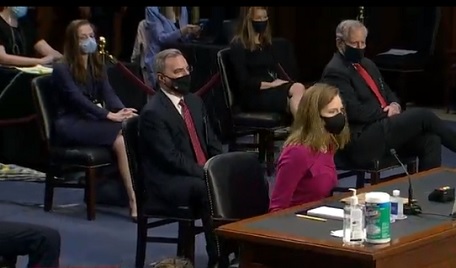The U.S. Supreme Court has been an issue in presidential elections throughout most of its history, although perhaps never quite like this year’s election.
 In the past, both political parties have tried, often with little success, to make the court or certain decisions a major campaign issue in the eyes of the public. But unless there is a decision that triggers public passions, for example, a Bush v. Gore ruling, the court is likely to fall to the side as an election issue, victim of more pressing voter concerns, such as the economy or health insurance.
In the past, both political parties have tried, often with little success, to make the court or certain decisions a major campaign issue in the eyes of the public. But unless there is a decision that triggers public passions, for example, a Bush v. Gore ruling, the court is likely to fall to the side as an election issue, victim of more pressing voter concerns, such as the economy or health insurance.
William Ross of Samford University Cumberland School of Law has studied and written about the court as an election issue for a number of years, In one of his early law review articles on the subject, he wrote:
“The President’s power to nominate federal judges has emerged as at least a moderately important issue during the past several presidential campaigns, and judicial issues were more prominent in the 2000 campaign than in any election since 1968.”
Ross attributed the trend to the “growing salience of the courts in presidential elections reflects increasing public awareness of the power of federal judges, particularly the Supreme Court Justices, and heightened appreciation of the President's ability to influence the courts through judicial nominations.”
In a 2016 interview with The National Law Journal, Ross said the Trump-Clinton presidential contest was accelerating the trend of making the court an election issue. Then-candidate Donald Trump, as he did this year, released a list of potential Supreme Court nominees from which he would pick if elected and a vacancy arose. That was a “first” by a presidential candidate. Trump and Hillary Clinton also focused less on judicial philosophies and more on specific decisions that they wanted to see overturned, a bolder indication than in the past that a potential nominee would face a litmus test for a high court seat.
The Democratic Party platform that election year called for the overturning of Citizens United v. Federal Election Commission, the 5-4 decision eliminating federal limits on corporate and union campaign expenditures. The Republican Party platform called for Supreme Court nominees who would overturn the landmark abortion decision, Roe v. Wade; the 2015 same-sex marriage ruling, Obergefell v. Hodges, and the two decisions upholding the Affordable Care Act, NFIB v. Sebelius (2012) and King v. Burwell (2015).
This year, the Democratic platform states it will fight to pass a constitutional amendment that will not only overturn Citizens United and related decisions but will eliminate all private financing from federal elections. The Republican platform is unchanged.
Some of the justices’ decisions that have figured in past presidential elections include: Dred Scott v. Sandford, holding that slaves were not citizens (1860 election); Engel v. Vitale, striking down school-sponsored prayer in public schools, Baker v. Carr, and Reynolds v. Sims, reapportionment, and Brown v. Board of Education, ending segregated public schools (1964 election); Miranda v. Arizona, police warnings to suspects in custody (1968 election, and Roe v. Wade (1980 election).
In 2020, the confluence of a presidential election, a pandemic and a push to confirm a Supreme Court nominee in one of the shortest periods of time in modern history has created a perfect storm for the Supreme Court. Last term, the justices worked hard to avoid being pulled into the political arena by a series of politically charged cases involving challenges to subpoenas for Trump's financial documents, Trump administration plans to end delayed deportation for so-called dreamers, abortion clinic restrictions, and job discrimination against LGBT workers.
The justices largely succeeded in that effort by forming cross-ideological majorities. But with the Sept. 18 death of Justice Ruth Bader Ginsburg, the court inevitably would be drawn into the political crossfire.
As Trump Supreme Court nominee Judge Amy Coney Barrett goes before the Senate Judiciary Committee this morning, the nation will witness in real-time the political stakes. From Republicans' perspective, Barrett would be the sixth conservative justice, one whose reliable vote, they believe, will dilute or end the ability of Chief Justice John Roberts Jr. to control how far and how fast the court moves the law to the right. From the Democratic view, Barrett would be the conservative vote to reverse progressive victories, such as Roe and the Affordable Care Act, and any future progress on civil and consumer rights.
Because Democrats are angry over what they see as a rank power grab in Republicans’ push to confirm Barrett before Americans inaugurate the next president and are still bitter over the Republicans' blockade of President Barack Obama's Supreme Court nominee Merrick Garland in 2016, there has been increasing talk about “reforming” the Supreme Court. Proposals range from term limits for justices to increasing the number of justices.
For now, however, the nation needs to focus on Barrett. Supreme Court nomination hearings are often deeply unsatisfying with nominees today well-schooled on how not to reveal much of their own thinking. Still, no one is entitled to a lifetime seat on the Supreme Court. There is some value in putting a nominee through the process as a reminder of that fact and value as well to the rest of the country.
Marcia Coyle is a regular contributor to Constitution Daily and the Chief Washington Correspondent for The National Law Journal, covering the Supreme Court for more than 20 years.







